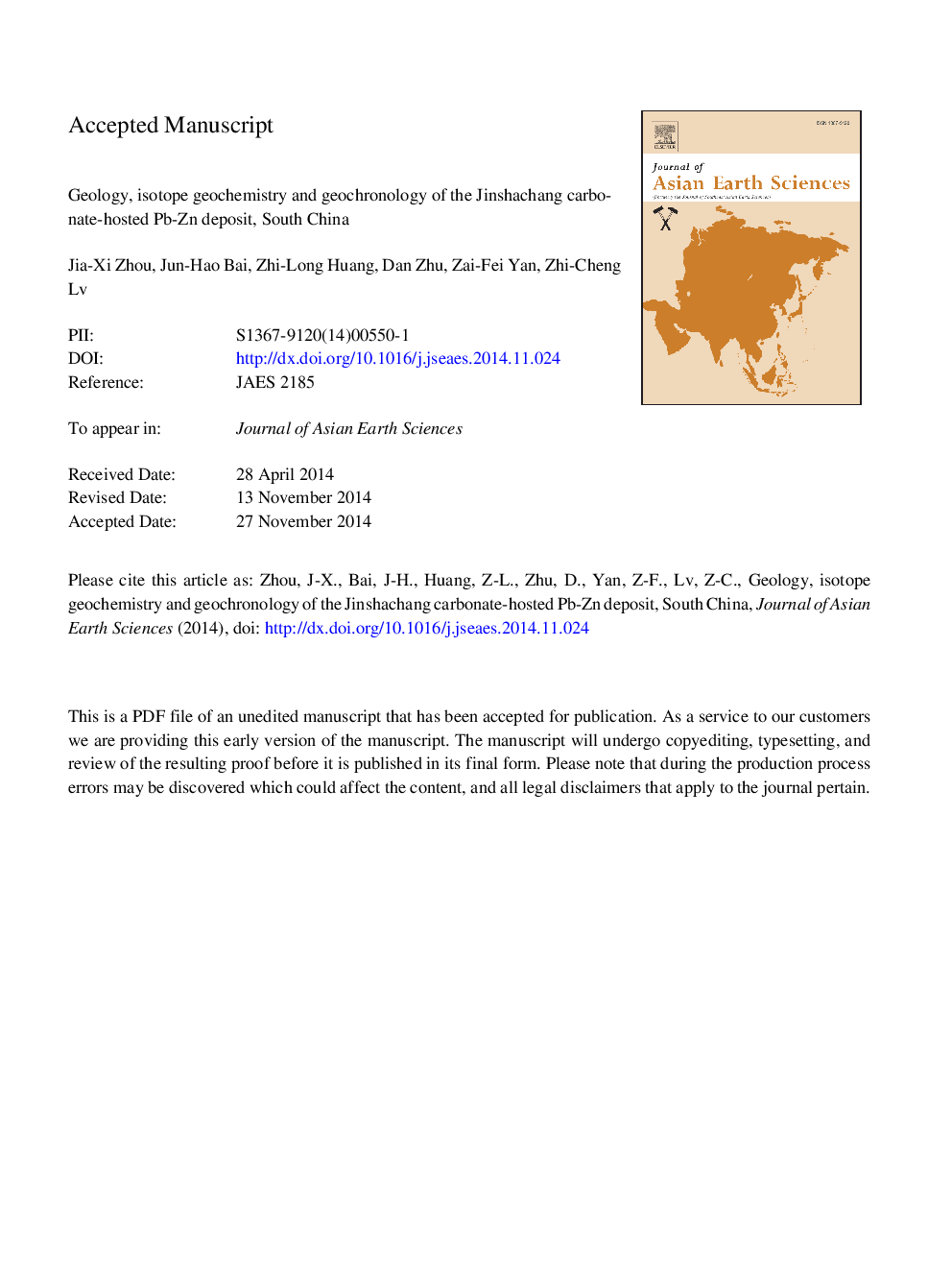| کد مقاله | کد نشریه | سال انتشار | مقاله انگلیسی | نسخه تمام متن |
|---|---|---|---|---|
| 6444382 | 1640371 | 2015 | 56 صفحه PDF | دانلود رایگان |
عنوان انگلیسی مقاله ISI
Geology, isotope geochemistry and geochronology of the Jinshachang carbonate-hosted Pb-Zn deposit, southwest China
دانلود مقاله + سفارش ترجمه
دانلود مقاله ISI انگلیسی
رایگان برای ایرانیان
کلمات کلیدی
موضوعات مرتبط
مهندسی و علوم پایه
علوم زمین و سیارات
زمین شناسی
پیش نمایش صفحه اول مقاله

چکیده انگلیسی
The Jinshachang Pb-Zn deposit, an exceptionally radiogenic Pb-enriched sulfide deposit, hosted by dolostone of the Upper Sinian (Neoproterozoic) Dengying Formation and the Lower Cambrian Meishucun Formation, is located in the western Yangtze Block, about 300 km northeast of Kunming city in southwest China. Ore bodies in this deposit are dominated by strata-bound type and steeply dipping vein type. Primary ores in these two types are composed of sphalerite, galena, fluorite, barite and quartz with massive, banded, veined and disseminated structures. Twenty-seven ore bodies in the Jinshachang deposit host 4.6 million tons of sulfide ores at average grades of 4.07 wt.% Pb and 5.03 wt.% Zn. Quartz separates from the sulfide ores have δDH2O values ranging from â137â° to â86.2â° with an average of â114â° (n = 7), lower than those of magmatic, metamorphic and meteoric water, suggesting a contribution of organic water. δ34SCDT values of ninety-one sulfide separates range from +1.1â° to +13.4â° with an average of +5.7â°, lower than those of evaporites (δ34SCDT = +15â° to +35â°) in the Cambrian to Triassic sedimentary strata in NE Yunnan province. δ34SCDT values of eight barite separates range from +32â° to +35â° (average +34â°), within the range of evaporites. These data suggest that S2â in the hydrothermal fluids derived from evaporites by thermo-chemical sulfate reduction (TSR), whereas SO42â directly originated from the evaporites. Six sulfide separates have highly radiogenic 206Pb/204Pb ratios ranging from 20.74 to 21.18 (average 20.92), 207Pb/204Pb ratios ranging from 15.85 to 15.89 (average 15.87), and 208Pb/204Pb ratios ranging from 40.89 to 41.42 (average 41.16). The Pb isotopes of the sulfides plot above the upper crust Pb average evolution curve and overlap the Cambrian sedimentary rocks, but are different from the Sinian dolostone. This indicates a crustal source of Pb most likely derived from the Cambrian sedimentary rocks. The initial 87Sr/86Sr ratio of seven main stage sphalerite separates from the Jinshachang deposit is 0.713, which is higher than those of the Upper Sinian Dengying Formation dolostone (0.708-0.710), Lower Cambrian carbonates (0.708-0.710), Devonian to Lower Permian sedimentary rocks (0.707-0.711) and Middle Permian Emeishan flood basalts (0.704-0.708), and lower than those of the Proterozoic folded basement rocks (0.724-0.729), but similar to those of Lower Cambrian black shale (0.712-0.714). Therefore, the Sr isotope data of the sphalerite support the view that the Lower Cambrian sedimentary rocks, in particular the black shale, were important source of metals. The main stage sphalerite separates have an Rb-Sr isotopic age of 206.8 ± 3.7 Ma, reflecting the timing of Pb-Zn mineralization. This study suggests that the Jinshachang Pb-Zn deposit is an epigenetic, thrust fold-controlled and strata-bound deposit with fluids and metals derived from the Cambrian sedimentary strata.
ناشر
Database: Elsevier - ScienceDirect (ساینس دایرکت)
Journal: Journal of Asian Earth Sciences - Volume 98, February 2015, Pages 272-284
Journal: Journal of Asian Earth Sciences - Volume 98, February 2015, Pages 272-284
نویسندگان
Jia-Xi Zhou, Jun-Hao Bai, Zhi-Long Huang, Dan Zhu, Zai-Fei Yan, Zhi-Cheng Lv,